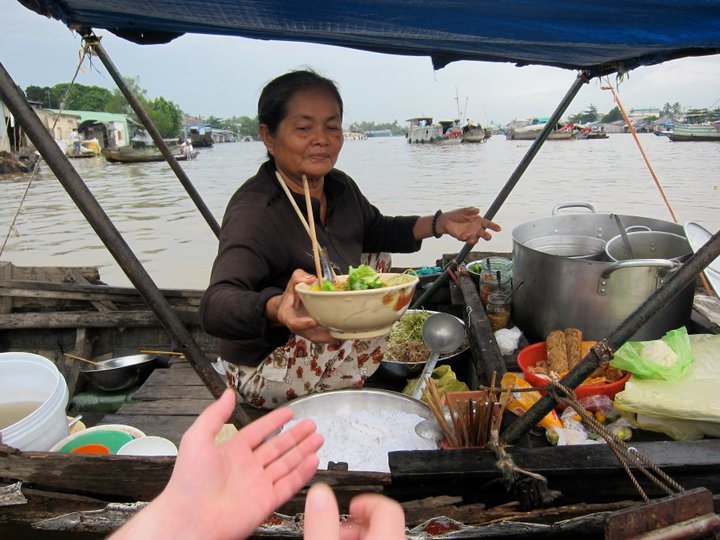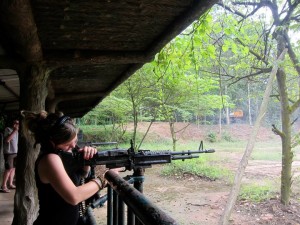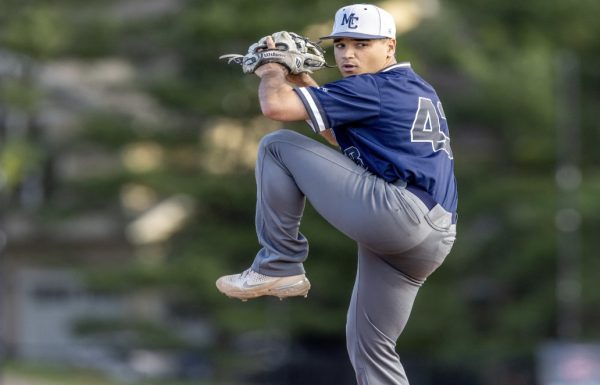Revisiting Vietnam: The Haunted Paradise
This story was awarded First Place in Feature Writing by the ASPA
March 11, 2011
The first few days in Ho Chi Minh my friends and I explored under the torrid sun; taking in the city and eating the spiciest and wildest food we could find. The restaurant seating was almost always outdoors and the chairs were like that of a child’s playroom- colorful, plastic and miniature. The Vietnamese people were overwhelmingly friendly and often in awe of seeing five, seemingly huge Americans.
As I strolled the busy streets buzzing with the sound of motorbikes, many of the Vietnamese men would innocuously stare, presumably at my blonde hair and tattoos, which were clearly foreign. I felt like a celebrity but less graceful, as I excitedly grinned and waved. Little kids would approach us travelers wide-eyed and puzzled, stopping just short of our pale legs to give us an extensive evaluation. One beaming mother lifted her infant up towards me, motioning to take a picture of her ear-pierced daughter dressed in bright polka dots.
Very few restaurants or stores appeared to have any semblance of a door, just an open wall like a garage or a dollhouse. They were family-run businesses expressed by their genuine interest in our patronage. It was quite unlike the indifferent disposition of the average American department store clerk or deli worker. Although the U.S. had a presence in the country for almost 20 years, I had yet to find much of a trace.
***
It isn’t uncommon for boys to count down the days until Christmas, the last day of school or a new movie release but back in the 1960s and 70s there was a different reason for marking days off of a calendar for young Americans. They called it being “short,” that meant there were only a number of days left before their mandatory one year tour of duty completed in Vietnam.
“After my first thirty or forty days of being there I stood at a memorial service of a soldier that was killed. Then, flash forward to ten months later- I’m standing again at a memorial service for another soldier,” Sgt. John Thomas accounts. “I think to myself- ‘Wow, I’m still here’.”
As the prayer was being read, John made his own dire plea.
“I just prayed I’d make it out alive. Back to… ‘the world’, as we called it.”
Vietnamese tourism has risen by 286 percent in the past ten years generating 3 billion dollars in annual revenue, according to the General Statistics Office of Vietnam. With beautiful landscapes and the US dollar stretching a long way Southeast Asia has been a booming travel destination. As many as 400,000 Americans are expected to visit Vietnam this year, according to the Vietnam National Administration of Tourism.
***
Just blocks away from where a young John opened up his fateful draft letter 42 years ago, I packed up my rucksack to explore Southeast Asia and fulfilling part of my goal- to see the world.
After two subway rides, two flights, a cab and 25 hours of travel I finally arrived in Ho Chi Minh from New York City.
After freshening up at the hotel we made it down to the lobby to ask Tink, our new pal at the front desk, how to get to some of the bars we had read about in our guidebooks. He had a petite frame, red wire-rim glasses and an adorable femininity about him.
“You going out now?” Tink asked surprised while looking questionably at his watch then back up at us. It was after ten.
“No good, no good to take your bag. Motorbike might take it,” he said acting out a predatorial purse snatching.
We honored Tink’s advice and left our purses and all but one camera bag back in the hotel room and followed the arrows he had marked on our free hotel map. It was late, dark and desolate and when motorbikes whizzed by I was glad I didn’t have to clench on to my bag from the new fear that our little Tink had instilled in us.
***
John is from the neighborhood. You can tell from his thick East Village accent, popularity and if you’re new to the bar- he will proudly tell you so. “Are my mountains blue?” he asks me every time I bring him a Coors Light, referring to the cold activated label. He has a hard personality but a gentle heart.
John drinks at my bar with me at least once a week and has for the last three years. Being a Vietnam vet does not define him, but it has had quite an effect on him. He can be easily agitated, impatient and brutally honest. But I’ve learned to keep the juke box down, wait until his beer is completely finished before offering up a new one and shower him with attention.
John makes sure to make his way through the bar saying his hellos and cracking jokes. He greets the ladies with a deep sing-songy, “How you do?” that often makes them giggle and blush. He plays the life of the party, singing Frank Sinatra over the jukebox and tells tales of his days as a Golden Glove boxer, before he went to Vietnam.
Occasionally he’ll mention his war, especially during fleet week when him and other veterans will treat the young sailors to endless beers and whiskeys. Other times, on a quiet afternoon, he will tell me stories of his life in the army, stopping just short of any gruesome or painful memories.
At first I had some anxiety about telling him about my impending trip, unsure at how he’d react.
“Why the hell would you want to go there?” he said.
***
The U.S. Army gave each soldier everything he needed to board the plane: military ID, uniform, boots and hat. John was ready to board the plane in San Francisco dressed in fatigues with his sole personal belonging tucked into his back pocket- his wallet which contained pictures of his family and a pretty brunette from the Bronx, Mary Anne.
John made one last phone call to his mother who asked, “Johnny, are you coming back to me?”
“What are you talking about? Of course, ” he said matter of fact, hiding his fear from her.
On the afternoon of Jan. 7, 1968 the 47th Infantry, 9th Division, 2nd brigade, 4th Battalion flew into Bien Hoa Airport. John was no longer John he was ‘Sergeant John T.’ and would be referred to as such for his mandatory one-year of service.
“I was immediately scared. The reality hit me and I knew it was a matter of life and death,” John recalled.
***
John and his unit were immediately loaded into trucks from the airport and moved down south to the Mekong Delta Region in Southwest Vietnam, where significant fighting had been taking place for the past year.
John and his unit the Mobile Riverine Force, armed with M-16s and M-60s would traipse through thick mud while bulky rucksacks hung from their tired backs filled with three days worth of ammunition and canned meals.
The night of his birthday John recalls being asked an important question. Not if he wanted chocolate or vanilla cake or what kind of liquor he wanted to shoot down with his pals. But how he wanted to kill.
“Patrol or ambush?” his superior asked him.
“Ambush.’
He chose to wait patiently for someone to signal and then fire into the darkness. He was stationed on the grounds of a pagoda where he spent the night clenching his M16, laying on a cool marble slate he assumed was a grave.
“How about that for a 20th birthday?” John said with his white eyebrows raised.
Unfortunately the painstaking missions were part of the job and John had no choice but to fight, not just for democracy, also for his own life. Over 58,000 American soldiers were killed in the course of the war.
“There is a lot of stress involved,” says John. “You come back from an operation, back to base and you breathe a nice big sigh of relief. You were living in constant fear- no one wants to go home early.”
When John was doing river patrol with his unit, their job was to trust no one. When they spotted a sampan, a long low-lying boat, approaching them, they would immediately motion for it to stop for inspection. They would check the boat for weapons and identification.
“You know if they started to flee they’re up to something,” John explains. “We would fire a warning shot to wake them up.” If they caught the enemy they became prisoners of war.
POW’s were often held in military prisons, but occasionally they would become a Chieu Hoi. A Chieu Hoi is a soldier that was once fighting with the other side and defected to work with the South Vietnamese and U.S. armies. John’s platoon had a Chieu Hoi named Bin.
“They were often prisoners who had been cornered into fighting with us or decided to switch sides because they thought the Americans were going to win,” John said.
Speculators guess that less than 25 percent of the defections were genuine. Sometimes after Chieu Hoi’s were fed, clothed and given freedom they would escape in the middle of the night, returning to the other side.
“He was a good one,” John explains when pointing at a picture of Bin posing on a dusty brown road with a floppy green hat. “He wanted freedom.”
As John slowly rises out of his chair to retrieve another beer, I try hard to comprehend trusting a perfect stranger knowing they were once out to kill you.
“What do you think? You’re gonna go to war unarmed?” he snaps after I question if Bin was given firearms like the rest of the guys.
***
The Cu-Chi tunnels, one of the most famous battlegrounds from the Vietnam War, is hours outside of the bustling part of Ho Chi Minh so two friends and I were forced to take an excruciating bumpy van ride on painfully barren roads to arrive at the site.
At the beginning of the tour we were sat down in what was once a bunker to watch a video. It began by explaining how peaceful the Cu Chi Village once was, and illustrated this point by black and white videos of school children studying and women riding bicycles under a canopy of palm leaves, all being scored with cheerful, melodic music.
Next, a dismal cloud rolls in over the tranquil village, the music turned dark and venomous and an awkward voice over translator states:
“Cu Chi, a land for relaxation and vacation was devastated by cruel Americans… Who was their target? Like a crazy bunch of devils they fired into women and children…Buddhist temples…”
The list of “targets” went on and on, mentioning everything from trees to school supplies. The video then told heroic tales of Vietcong guerillas and how many Americans they killed as the three of us shifted awkwardly in our seats.
I struggled to find a fitting reaction to the allegations being made. Although, I know there are two sides to every war, I wasn’t sure if the video was intended as a historic glimpse into the propaganda of the NVA or if we were actually trying to be convinced by the tour that Americans were evil. Confused and saddened I traipsed back out onto the trail.
The tunnels and Cu Chi guerillas did put up a good fight against the American troops. The tunnels, that stretch 75-miles, were often thought to be much shorter and contained strategically placed booby-traps. The guerillas spent hours and sometimes days underground, making explosives, trap doors and punji stake pits.
“A lot of it was luck,” John states when recalling the abundance of booby traps down south where he was stationed. “You had to be cautious every single step.”
After the U.S. Army dropped giant bombs from planes and shot heavy mortars from boats, the grounds troops were sent in to scour the area. Lo and behold, there would still be shots firing from the dust and destruction from the Viet Cong hiding in the tunnels. Occasionally, the U.S. troops sent specialized “tunnel rats,” who were sleek and small and were able to squeeze into the tiny tunnels in seek of Charlie.
“Hopefully they didn’t run into women or children,” John says, referring to the tunnel rats. “We would never want to harm them, but unfortunately, if someone starts shooting at you, you have no choice but to defend yourself.”
“There’s lots of sacrifice in war on both sides,” John says grimly. “A lot.”
I watch John tense up whenever war talks get too candid. He was exposed to Agent Orange, which gave him a blood disease. He knows exactly how many men in his platoon lost their lives the year he served. 34.
One of them his best friend, died in his arms. John saw many people die, some by his own hands and is still haunted by the memories. It is obvious to me as I watch an array of emotions from across his kitchen table.
“That stuff is for my therapist, not you,” he says staring down at his beer and then shaking his head as if to empty the thoughts from his head.
As John flips through the pictures from Vietnam his narratives and expressions are mixed. The tales of camaraderie of the young men are in great contrast to those involving the intensity of war.
John stops at a page and points to a specific picture. It’s of two bodies tied to telephone poles, their limbs limp and their heads sagging lifelessly from their tattered bodies. It’s a frightening picture one might come across in Time magazine or a war museum, quite odd to be squeezed into the plastic sheath of a three-ring binder. John explained to me that the corpses were dangerous VCs that John’s platoon had been ordered to kill.
“We had to take them to town to show the people that we got ‘em,” he casually states.
The picture is haunting. Not just because of the content but its random placement amongst jovial shots of young men gathered at base camp smoking cigarettes and drinking beer, things I feel young American boys are supposed to do.
Beer was always a staple at base camp, John explains. In fact, after a mission their captain wouldn’t allow the boat to be moved to a new location until they had finished their beer.
One night when John and the boys were kicking back and drinking, a red flare burst up into the dark sky. The color red was the warning for a mortar attack and they quickly rushed down into the bunker for safety. Once they reached the bunker, squeezed in like sardines, they looked around in panic.
“Who’s got the beer?” one of them exclaimed.
“What do you mean, you forgot the beer?” the others chimed in.
There was no way they were going to spend their evening shoulder to shoulder in the steamy bunker without any refreshments, so two volunteers were called on to dash up to grab some beer. And beef jerky, of course.
***
After we left Ho Chi Minh we traveled through the Mekong Delta, an area that had been nearly destroyed during the war, going on day trips on boats where we were fed local island delicacies, each one fresher and more colorful than the next. We spent a few dollars a day and took pictures that paled in comparison to the priceless memories and experiences. We were gracious and respectful and were received with an abundance of warmth.
***
John asked me how the people treated me in Vietnam and he raises his eyebrow suspiciously and acts surprised when I tell him they were really welcoming.
“How did the civilians treat you?” I asked.
“Well, G.I. was number one while we were there. We’d leave and Charlie came in, then Charlie was number one,” he says raising his voice and relaxing his arms, defeated.
“You would have to be a fool to go,” he quickly responds when I ask if he would do it again, knowing what he knows now.
After the Tet Offensive and the public perception of the Americans losing the upper hand, Lyndon Johnson made a bold move, deciding to halt the North Vietnamese bombing at the Ho Chi Minh border and suspending plans to send 250,000 more troops.
“What are we doing here?” John says mimicking the troops when news spread that the President was not backing them up.
“We are fighting and making sacrifices. We’ve got men maimed, lost limbs, mental breakdowns, fatalities and we’re giving up?” He says mournfully. “We really thought the war was winnable.”
“I got sold out,” he says sadly. “I am a patriot. I was when I went to war, while I was there and I still am,” he says lifting his head back up.
John sympathizes with the troops overseas today and questions the validity of America’s involvement in those wars with the resentment he harbors from his time deployed. John hasn’t voted in a single election after the war because he feels his government let him down.
“I thought we were trying to bring them peace,” he says disappointed.
***
“Where is the border?” I begged, banging on the drivers window.
Jim, my fellow traveler, and I had just been dumped out into a vacant lot after a long van ride we had anticipated would take us right into Cambodia. We had spent an amazing two days lounging on the sandy beaches of a tiny Vietnamese island and still numb from the banana wine we had hoped for a smooth transition to our next destination.
I anxiously waited for a response. The driver took a long pause that I had assumed was necessary in making a helpful translation but instead of offering help he sped away, leaving Jim and I in a pool of hopeless dust. The other riders had dissipated and we were left alone. My heart raced and I swallowed nervously.
Across the lot were four men on motorbikes revving their engines aggressively. Before we could even get our bearings they had encircled us. The men were motioning for us to get on the bikes, excitedly reaching their arms out to grab our heavy rucksacks off our backs.
“Cambodia. The border. How far?” Jim asks dropping his pack while motioning for me to do the same. The growls from the bikes and the men’s insistence on jumping upon them had us both feeling uneasy. I was not eager to split up with Jim ride for a precarious ride with a complete stranger who spoke no English.
“Border,” they each repeated over and over, nodding but unable to elaborate.
Confusion ensued until the youngest of the men kindly shut off his bike and motioned for us to come sit down and look at a map. After a lengthy discussion we agreed to take the motorbikes across the border and to the next bus station, which was 20 miles deep into Cambodia, as precarious as it was we had no alternative.
Luckily I was partnered with the young fellow who gently placed my rucksack on his lap and buckled a red helmet on my head. He patted a small space on the seat behind him. I gave Jim a brief, ‘here goes nothing’ nod and jumped on.
**
“I kissed the ground,” John says when recalling the day he made it back to the US.
He had heard about the anti-war protests in Washington D.C. and masses of activists gathering at Washington Square Park, just blocks from his family’s New York apartment but he wasn’t sure what to expect.
“I get back and there was nothing. Nobody cared about us. No hooting or hollering, ‘glad you made it’s,” he explains his voice softening with every word. “We thought we were patriots. Fighting for our country.”
About 25 percent of the men sent to fight in Vietnam did not volunteer but were drafted, their lives being forever changed when or if they made it back.
John explains, of course his family was ecstatic to see him and some friends would came by to welcome him home but other than that he felt him and his time spent risking his life went disregarded.
“If anyone said anything at all to us it would be ‘war-monger’ or ‘baby killer,’” he says, still embarrassed and hurt.
“Once you take your uniform off your just a guy again,” John stated then takes a long deep breath.
I can see it hurts him to remember a time when he was sent away to grow up way too fast to return with no war won and an icy public reception. He seems sad, that it might have been in vain.
“We really did think we were giving them freedom.”
***
As we approached the border, my left knuckles white from clenching the base of my seat, I felt a sense of nostalgia and carefully waved goodbye to Vietnam. It was beautiful and welcoming, quite contrary to the violent photographs and war movies I had always equated it with. Although it was gratifying to make it to the border, it was bittersweet.
As we made our way into the Cambodian countryside, I began to relax, calmed by the lush green vegetation and the expansive red clay road ahead. I loosened my grip from the waist of my new companion and he taught me how to say hello in Cambodian.
“Akun,” I repeated.
“Yes,” he said proudly over the low hum of the motor.
I giggled at how leery I had been about the ride that was sure to be a highlight of my trip.
In a war-torn region that John had traveled half way around the world in hopes of instilling peace, I had found serenity. I was not an invader. Nor a patriot. Nor even an American, the same way there were not Vietnamese. I was just a woman sharing smiles and laughs with new friends in an ancient paradise.
I could never explain this to John or make him understand. He would curse and shake his head. The same way I can only listen to his stories and not completely understand them.
As the sun beat down on my shoulders cooled by the breeze of the motorbike I entered Cambodia, I glanced back.
Vietnam.
I felt like I was leaving home.







Chayim Tauber • Apr 14, 2012 at 9:55 pm
This is a brilliantly organized bit of writing. The way the past turmoils of the place were interwoven with the story of your vacation; a before-and-after snapshot of sorts was a brilliant piece of writing. Can easily see why this would be an award winning piece.